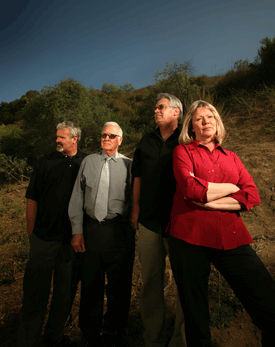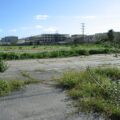 Developers of Simi Valley’s Runkle Canyon claim the water tested clean. Then a band of citizens discovered super-toxic goo seeping from the ground
Developers of Simi Valley’s Runkle Canyon claim the water tested clean. Then a band of citizens discovered super-toxic goo seeping from the ground
By Michael Collins
Los Angeles CityBeat/ValleyBeat – June 21, 2007
The sweating point man leads a small group up the dusty inclines of Runkle Canyon. This undeveloped swath of chaparral near the town of Simi Valley is where KB Homes hopes to build 461 residences. The unforgiving sun blazes as Terry Matheney heads toward the same creek water that he had already warned the city was suspiciously shiny, with an oily sheen that should be tested for toxins. He volunteered to take them there.
The city declined, saying the developer had already done tests on the surface water in 2003, examining one sample on the 1,595 acre property. So, one week before this day’s march, Matheney went to collect the gooey fluid himself. He was in for a big surprise.
“I was filling these plastic bottles when my chemical gloves started bubbling,” says Matheney. “I couldn’t believe it! I thought it’s obviously eating its way through my gloves so I just tore them right off of me because it looked like it was permeating the rubber!”
Serious as it is, the story sets off gales of laughter. Matheney’s a genial sort, a creature of these dry and dusty dells about 35 miles northwest of downtown Los Angeles where he hikes with his dog Jake. He works at AeroVironment in Simi Valley, a defense contractor that tricks out spy planes with names like Hawk Eye, Switchblade, and the Global Observer.
But the man is angry. He thinks there’s something obviously wrong with Runkle Canyon. It is, after all, next to the Santa Susana Field Laboratory (SSFL), otherwise known as Rocketdyne, site of innumerable rocket tests and the worst nuclear meltdown in American history, spewing radiation from the unconfined Sodium Reactor Experiment the night then-Vice President Nixon squared off against ex-Soviet Premier Nikita Khrushchev in the famous Kitchen Debate in 1959. The effects of that meltdown would be felt decades later.
Taking this hike is no Cold War memory lane for Matheney, however. It’s a journey that’s transformed him into “Toxic Terry,” one of a crew of concerned citizens who call themselves the “Radiation Rangers” – their way of laughing at what they see as the sheer insanity of developing this possibly-polluted land.
Now he’s headed up these hills with a lab technician and his neighbors to professionally sample the goo he saw in the water. Little does he know that the results of his reconnaissance would yield proof of Runkle Canyon pollution that never appeared in the Runkle Canyon development Environmental Impact Report. That EIR was passed in 2004 by the Simi Valley City Council, which apparently didn’t notice that tests had not been done for some very nasty metals in that sole surface water sample, including the notorious one that the Radiation Rangers would find: arsenic.
“They could call it Three Mile Island Shores or Chernobyl Estates,” Matheney says. “It’s ludicrous. My company is sending our drones over there to protect our troops and the United States from possible terrorists, from them finding a nuclear bomb and getting in here to create real havoc, and here we have a nuclear threat in our backyard. Boeing and Rocketdyne are wrapping themselves in the American flag and claiming they’re defending us when what they’re really defending is that dollar. What’s happened to America, that the city council would sell us down the river for a profit?”
Accompanying us on this journey through majestic Valley Oaks and over land parched by drought were other members of the Radiation Rangers, including “Fearless Frank” Serafine, an award-winning sound engineer and composer who recently performed at the Henry Fonda Theater with Thomas Dolby. And “The Good Reverend John” Southwick who marries folks at WeMarryYou.com. Absent this day, because of work, is the vice president of a huge financial company, “Perchlorate Patty” Coryell, who runs StopRunkledyne.com.
“All we were asking for was an unbiased, comprehensive chemical and radiological characterization of Runkle Canyon before construction activities began,” says Coryell later. “The city council ignored these requests and instead asked various federal agencies to go back over the same developer-generated reports and render an opinion. Most of these reports have been completely discredited – and the rest are so incredibly limited in scope that they are meaningless. Finally, we paid to have the necessary testing done ourselves. In two weeks, we had answers, not opinions.”
Coryell counts around 60 other Simi Valley residents as opponents of the KB Homes development plans for Runkle Canyon. Most are affluent white Republicans who never knew activism until Rocketdyne’s lethal legacy brought them together to fight a development that CityBeat has estimated will launch over 112 tons of dust into the air, dust impacted by high readings of the leukemia-causing radionuclide strontium-90 (see our cover story “Neighborhood Threat,” March 10, 2005). Strontium-90 readings in Runkle Canyon average 37 times normal for the area with a high over 411 times above background.
But radiation isn’t on the minds of the men heading up the canyon this day. They know that the slime’s sheen wasn’t caused by radiation. They also know that if they collect the gunk themselves, the city and the developer will reject it outright as being biased. So they reached deep into their pockets and hired Ron Lovato of Moorpark-based Pat-Chem Laboratories, who also soldiers along with the band as it makes its way higher through this beautiful mountain landscape. Lovato’s kit includes water sampling ladles, soil scoopers, and various containers for volatile and semi-volatile organic compounds. A heavy cooler designed to keep the samples properly preserved for the lab is lugged laboriously.
Careful to avoid any contact with his skin, Lovato uses a long white scooper to dip into the mysteriously streaked creek water. Rust-colored mud is scraped from where the creek has begun to dry up and recede. After an hour of sampling, Lovato carefully stows his cargo in the cooler for the long walk back.
“The only reason I knew where the water was is that I knew where the water table was before and where the cattle got their water,” Matheney says. “There are cattle tracks all over the place. The cattle are going down and drinking out of that.”
“If we can walk directly back in there and the first place we find water it has got that slime on it, how the hell can they not find it?” Matheney continues. “And [KB Home is] unable to, and yet they’re doing all the testing.”
Arsenic and Waste
The results of the nearly $3,000 worth of collection and analysis by Pat-Chem Labs were astonishing. An astronomical amount of poisonous arsenic was detected in the surface water and adjacent soil of Runkle Canyon. In wetter times, that water eventually makes its way downhill to collect in Runkle Reservoir, up gradient of the Arroyo Simi. Water reaching here, or migrating through the groundwater, replenishes an aquifer that supplies water to tens of thousands of people in Simi Valley. That extracted groundwater makes up about 20 percent of the water blend utilized in the area.
Due to increasing awareness of the lethality of arsenic, the Environmental Protection Agency lowered the “maximum contaminant level” (MCL) for the substance in drinking water from 50 parts per billion (ppb), established in 1975, to 10 ppb in 2001. “A 1999 report by the National Academy of Sciences concluded that the 50 ppb standard did not adequately protect human health,” EPA says in describing its new arsenic rule. “EPA set the new MCL of 10 ppb to protect the public against the effects of long-term, chronic exposure to arsenic in drinking water. The new MCL will decrease non-fatal and fatal bladder and lung cancers and will reduce the frequency of other health effects such as diabetes, developmental problems, gastrointestinal illness, and heart disease.” Arsenic has also been linked to many other non-fatal conditions.
Runkle Canyon’s surface water readings for arsenic are 15 times the MCL for drinking water, over 21,000 times the EPA’s “preliminary remediation goal” and 37,500 times the agency’s “public health goal” for potable water.
The mud sample was laced with arsenic as well, coming in at over 548 times the EPA’s preliminary remediation goal for the contaminant in soil. That amount of the toxin is also 213 percent of the Department of Toxic Substances Control (DTSC) arsenic “field action level,” where further investigation is warranted.
As to the source of this arsenic, it seems logical to look uphill to SSFL which is probably more famous for its two partial nuclear meltdowns in 1959 and 1964; the earlier disaster releasing hundreds of times more radiation than Three Mile Island meltdown in 1979. However, arsenic has been found at high levels at the lab. As CityBeat has reported (“Blinded by the Light,” July 22, 2004), arsenic readings in the northern part of the Happy Valley section of Rocketdyne’s massive 2,850 mountaintop complex were detected in 79 out of 80 soil samples with 63 of them being over the field action level.
The toxic metals nickel and vanadium were also detected in the water at worrisome levels by the Pat-Chem lab, in the case of the later, tripping a government “notification level” designed to keep pollutants out of the drinking water supply. Nickel was over 12 times the EPA’s public health goal in water and vanadium came in at 1.8 times the notification level which is a threshold at which the most local government entity should be informed. That entity would seem to be the city of Simi Valley since it annexed Runkle Canyon in September 2004.
The Runkle Canyon water is loaded with potassium, calcium, and sodium. Merely pouring it onto chemical-rated rubber gloves causes them to bubble after about 15 seconds for reasons not yet understood. This water, which percolates to the surface through seeps year-round, is so caustic that it seems to possess the properties of sodium hydroxide, or lye. It’s as if Drano or Liquid-Plumr is flowing through Runkle Canyon.
“I don’t think we’ve seen numbers that high but we’re not qualified to say if it’s natural or unnatural,” said one Pet-Chem employee who asked to remain anonymous. “That’s the hardest goddamn water in your life. It’s a little bizarre. I would hope not too many people would touch that water.”
‘Mass Hysteria’
The Radiation Rangers didn’t want to test this suspicious water themselves – that’s what they thought the government was for. Then, this spring, the group decided to ask the city to demand that KB Homes investigate the mystifying muck even though they had been derided in the Simi Valley Acorn by Councilmember Glen Becerra. “If something is wrong up there, then absolutely we’re going to get to the bottom of it, but if it turns out something is not wrong, then I don’t want to see a complete devaluation of homes just because a few neighbors created mass hysteria,” Becerra said April 30.












Recent Comments